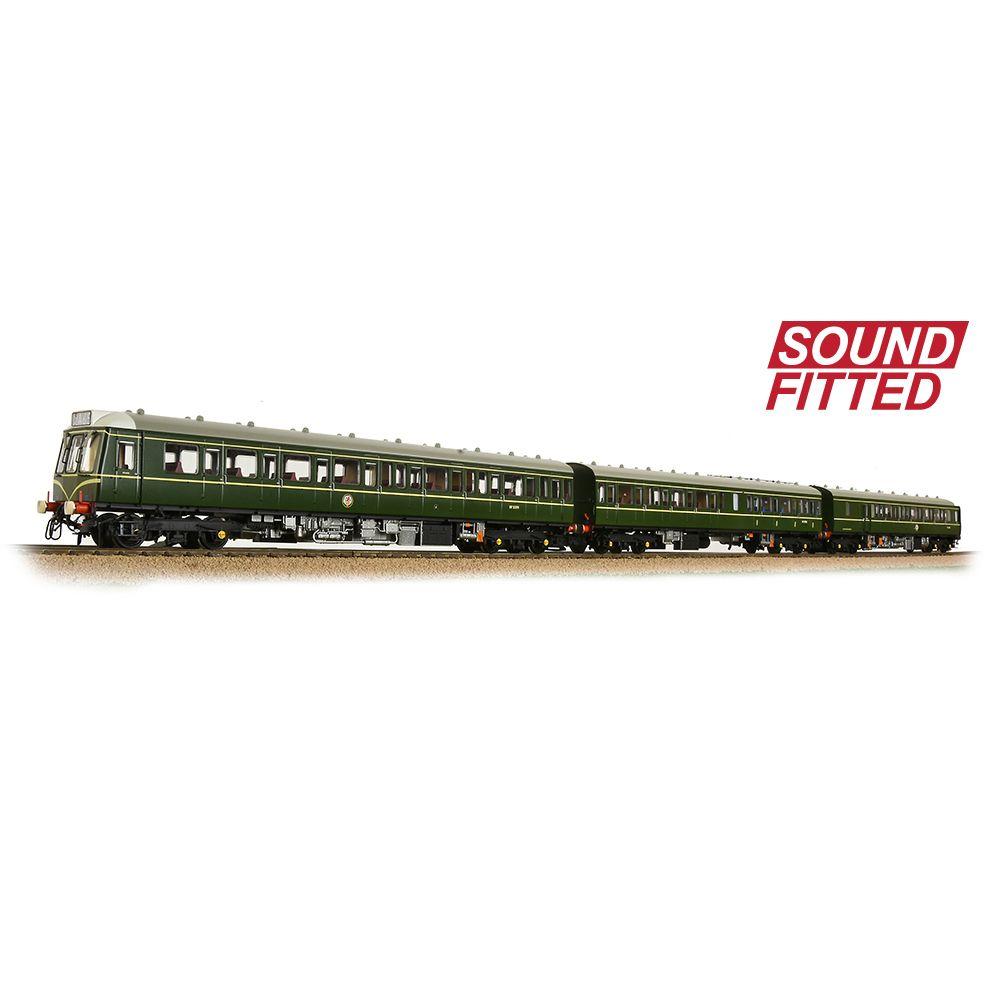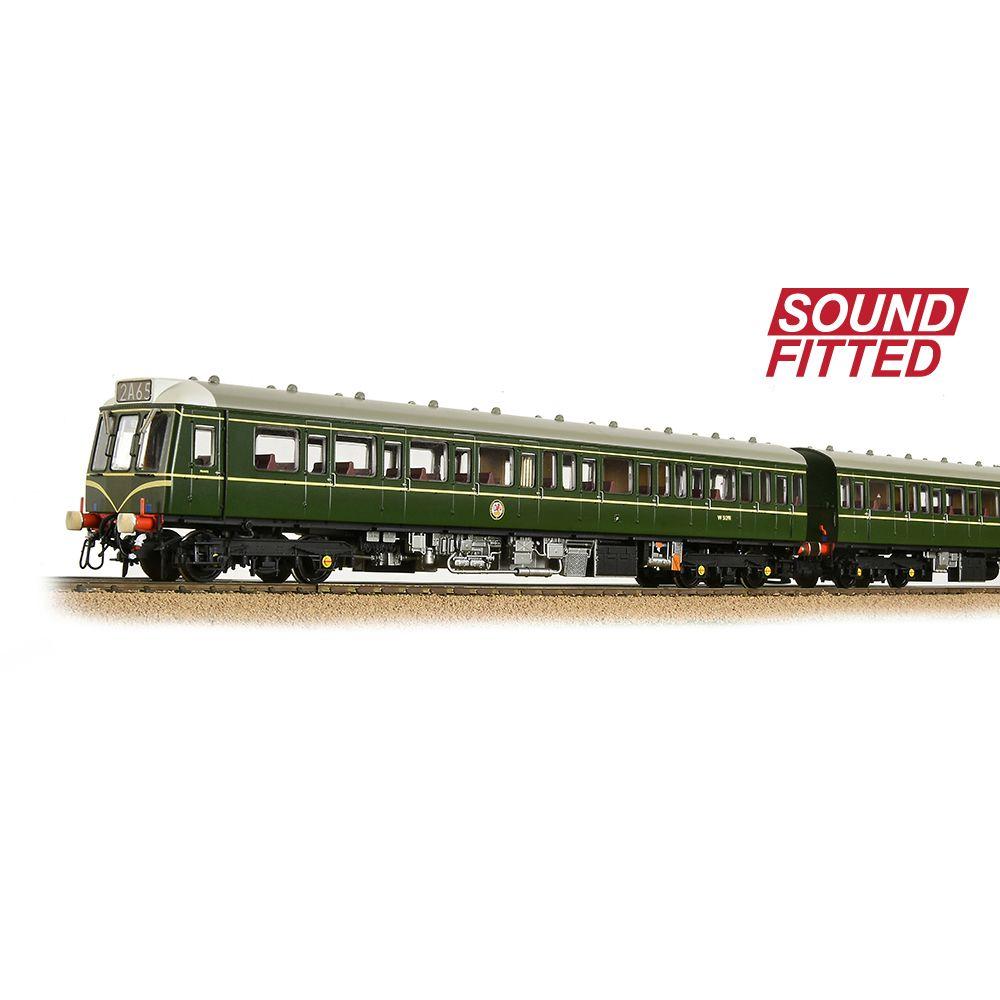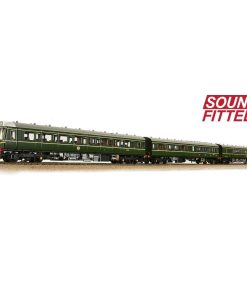BRANCHLINE OO Class 117 3 Car DMU BR Green Speed Whiskers DCC Sound Fitted BRANCHLINE
$ 639,99 $ 192,00
BRANCHLINE OO CLASS 117 3 CAR DMU BR GREEN SPEED WHISKERS (SOUND FITTED)
Announced as part of the Winter British Railway Announcements we are delighted to bring you this Class 117 3-Car DMU in BR Green (Speed Whiskers) livery. With a wealth of individually controllable lighting features, this model is also SOUND FITTED for a fully authentic experience!
Bachmann has designed the Branchline models of the Class 117 and its sibling, the single-car Class 121, from the rails-up, to achieve a new standard in fidelity to prototype in OO scale DMUs. The model is equipped with a low profile, underfloor driveline that permits reproduction of an unprecedented level of interior detail, with no intrusion from the motor.
Our SOUND FITTED model features realistic running sounds and much more – see full details of the sound functions below.
MODEL FEATURES:
- Bachmann Branchline OO Scale
- Era 5
- Pristine BR Green (Speed Whiskers) Livery
- 3-Car Unit comprising DMS No. W51391, TCL No. W59501 and DMBS No. W51349
- Headcode Boxes display 2A20 and 2A65
- Destination Blinds for Newbury and Paddington
- Accessory Pack
- NEM Coupling Pockets
- Close Coupling Mechanism
- Interior Cab Lighting
- Directional Lighting
- Illuminated Headcode Boxes and Destination Blinds
- Lighting can be controlled by chassis-mounted switches or via DCC
- SOUND FITTED – See below for function list
- Length 850mm (over couplings)
SOUNDS
F0 – Directional Lights – On/Off
F1 – Warm Engine Start-up / Shut-down (with F5 On – Cold Engine Start-up)
F2 – Brake
F3 – Single Horn (Speed & Direction Dependent)
F4 – Two-Tone Horn (Speed & Direction Dependent)
F5 – Cold Start (engage F5 before F1) / Light Load
F6 – Engine Cruise / Compressor Speed-up
F7 – Flange Squeal (at Speed Steps 1-39 of 127)
F8 – Detonators (Speed Variable)
F9 – Saloon Lighting – On/Off
F10 – Guard’s Whistle
F11 – Crawler Mode (Low speed & sounds only)
F12 – On – Guard’s Single Buzzer / Off – Driver’s Single Buzzer Response
F13 – On – Guard’s Double Buzzer / Off – Driver’s Double Buzzer Response
F14 – On – Driver’s Door Open / Off – Driver’s Door Closed
F15 – Passenger Door Slam (Before moving)
F16 – DMS Destination Blind Light – On/Off
F17 – DMBS Destination Blind Light – On/Off
F18 – Fade All Sounds
F19 – Windscreen Wipers
F20 – DMS Directional Lights – Off/On
F21 – DMBS Directional Lights – Off/On
F22 – Rail Join Clatter – Off/On (Speed Variable)
F23 – On – Passenger Door Open / Off – Passenger Door Closed
F24 – Cab Lights – On/Off
F25 – Handbrake
F26 – Air Tank Drain Down
F27 – Volume Down
F28 – Volume Up
Analogue Users: Please note that normal load running sounds and any other automatic or randomised sounds will also operate when this model is used on analogue control (DC) straight from the box!
CLASS 117 HISTORY
The BR Class 117 diesel multiple units (DMUs) were built by Pressed Steel from 1959 to 1961. When first introduced, these three-car units were all based with the similar Class 121 single carriage (railcar) units on British Railway’s Western Region for suburban work out of London Paddington. The units were largely based at Reading and Southall depots and they remained here for many years working these services.
Withdrawal of other DMUs facilitated moves for some units from the Western Region to Birmingham and Scotland, prior to the delivery of new units to replace them. They were given refurbishments. The first shake up in ownership occurred in the late 1980s, when the Scottish, Welsh, Cornish and Birmingham based units were transferred to Provincial Services, later Regional Railways, in the sectorisation of British Rail, while the Southall-based units transferred to Network SouthEast. They were replaced on the lines out of Paddington when the Class 165/1 ‘Network Turbo’ units came into service in November 1992.
They remained in service on the former Western Region until replaced by Class 150 and Class 153 DMUs during 1993. An attempt was made to remove them from Cornish work using Class 142 ‘Pacer’ units, but these non-bogie units proved to be a liability on the tight curves of the Cornish branches, increasing rail and wheel wear, and so the Pacers were moved to the North of England instead. They were finally replaced when Class 150s and Class 153s became available, having been freed up from other areas. They continued to work in Scotland until January 1998 where they were replaced with Class 156s.
For many years, passenger services on the Birmingham Cross-City Line were worked by elderly Class 117, along with Class 115, 116, 118 and 121 diesel multiple units, but all were withdrawn from service by 1995. In 2000, Class 150 Sprinter units replaced the Class 117 units on Silverlink, finally bringing to an end decades of service on Britain’s rail network.
Quick Shipping and Professional Packaging
Due to our long-term partnership in a long-standing partnership with UPS, FedEx, DHL and many other leading global carriers, we are able to offer an array of shipping options. Our warehouse staff are highly trained and will pack your products according to our precise and precise specifications. Your items will undergo a thorough inspection and be securely secured prior to being delivered. We ship to thousands clients each day across multiple countries. This is an indication of our dedication to being the biggest online retailer in the world. The warehouses are located in Europe as much as they are in the USA.
Note: Orders that include more than one item are assigned a processing time in accordance with the item.
Prior to shipment before shipping, we'll inspect thoroughly the items you've ordered. The majority of orders are shipped within 48 hrs. The time to deliver varies from 3-7 days.
Returns
We don't manage the stock in our warehouse and factory. Stocks are subject to change at any moment. You may not receive your order after the order has been made.
Our policy is for 30 days. If you have passed 30 days by since your purchase, unfortunately we can't offer you a refund or exchange.
The item cannot be used and in its original condition. It should also be in the original packaging.
Related products
RADIO CONTROL
RADIO CONTROL
(Clearance Item) HB RACING 44mm Heavy Duty Universal Drive Shaft/Rear/Steel/2Pcs HB RACING
RADIO CONTROL
RADIO CONTROL
RADIO CONTROL
RADIO CONTROL
RADIO CONTROL
RADIO CONTROL
RADIO CONTROL
(Clearance Item) HB RACING 5 Cell Main Chassis 2.5mm with Battery Tray (Cyclone) HB RACING
RADIO CONTROL
RADIO CONTROL
RADIO CONTROL
RADIO CONTROL





































